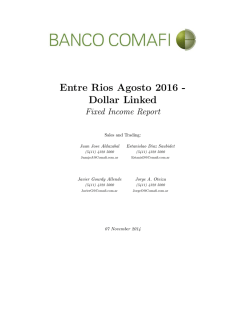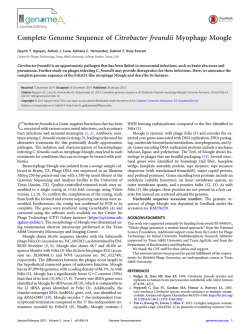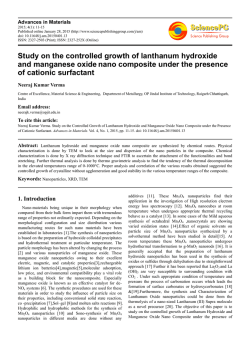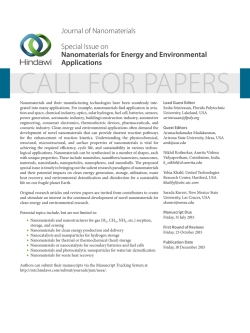
Synthesis of Alumina Nano-particles And Study of Heat Transfer
International Journal of Engineering, Economics and Management ISSN: 2319-7927, Volume 3, Issue 2 Synthesis of Alumina Nano-particles And Study of Heat Transfer Enhancement Akanksha Paraye Prof. (Mrs.) S.R. Mote Abstract — This paper describes the synthesis of alumina nanoparticles using sol-gel method. As Nanofluids have unique features different from conventional solid-liquid mixtures. Due to their excellent characteristics, nanofluids find wide applications in enhancing heat transfer. Therefore, a synthesized alumina nanoparticles was used as a nanofluid in double pipe heat exchanger to study and compare the heat transfer enhancement between base fluid (water) and nanofluid. catalysis, molecular separation, membranes, structural material and adsorbents catalyst. Alumina is one of the inert biomaterials used in implants. It is therefore a biodegradable material, well tolerated by the biological environment. Key Words — Alumina, nanoparticles, nanofluid, heat transfer, heat enhancement. Alumina nanoparticles were synthesized by sol-gel method by using aluminium nitrate, urea and distilled water as a precursors. A sol-gel method is the multi step process, involving chemical and physical processes associated with hydrolysis, polymerization, gelation, condensation, drying and densification. This process generally starts with the mixing of metal alkoxides or salts in water or in a suitable solvent (usually an alcohol) at ambient or slightly elevated temperatures. Aluminium nitrate and urea was added to distilled water and taken to magnetic stirrer for one hour at 40℃. A solution obtained by magnetic stirrer was placed in the sonicator for two hours to get homogeneous mixture. After vaporizing the excess solvents in a vacuum dryer for three hours, a wet gel was obtained which was then left at room temperature for 24 hours for its maturity. Finally, the gel was placed in hot air oven for calcined at 300℃ for 2 hour to get the nanaoparticles of alumina. II. EXPERIMENTAL WORK Synthesis of Alumina Nanoparticles I. INTRODUCTION Metal oxide nano-particales have been extensively developed in the last decades (ten years). Nano-Particles are the Particles in size range 10-9 m are known as nanoparticles or sub-micron particles. They are also known as quantum dots due to quantum property possess by them. OR Nano-particles have been described as ‘novel materials whose size of elemental structure has been engineered at the nanometre scale’.Nano-particles have been used as filler in both polymeric nano-composites to improve the mechanical, electrical and optical properties and metallic nanocomposites to control the electrodeposition. The oxides of aluminium materials are widely used in ceramics, refractories and abrasives due to their hardness, chemical inertness, high melting point, non-volatility and resistance to oxidation and corrosion. Ceramics based on alumina are widely used by modern industry as a construction material with several unique properties such as high mechanical strength and hardness, heat resistance, chemical inertness, and insulation characteristics. Another important application of materials based on alumina is the creation of various catalytically active complexes for the oil industry and cleaning of industrial emissions. Recently many researchers are showing interest on the preparation and application of nano-sized alumina or alumina composites considering their diverse properties. It is generally believed that the properties of such alumina particles are largely governed by the particle size, morphology, surface and phase homogeneity and these can be controlled by selecting a proper synthetic route. Alumina with desirable surface properties such as high surface area and mesoporous properties is most commonly used as a high-temperature catalyst or catalytic support and as a membrane. Synthesis of nano sized alumina has attracted great attention due to their wide spectrum of application in Preparation of Alumina Nanofluid There are two fundamental methods to obtain nanofluids: 1. Single-step direct evaporation method: In this method, the direct evaporation and condensation of the nanoparticulate materials in the base liquid are obtained to produce stable nanofluids. 2. Two-step method: In this method, first the nanoparticles are obtained by different methods and then are dispersed into the base liquid. In this experimental work alumuina nanofluid was prepared by dispersing synthesized alumina nanoparticles in base fluid (water). 15 gms of alumina nanoparticles were added to 10 liters of distilled water. 1 International Journal of Engineering, Economics and Management ISSN: 2319-7927, Volume 3, Issue 2 Heat Transfer Enhancement Pipe Heat Exchanger in A graph (graph 3.1) given below shows the enhancement in overall heat transfer co-efficient (inside) of base fluid and alumina nanofluid. The graph is plotted between the set point temperature and overall heat transfer co-efficient (Ui). It is very clear from the graph that alumina nanofluid shows better heat transfer coefficient than the base liquid with increase in its set point temperature. Where Y-axis shows the value of overall heat transfer co-efficient (inside) and Xaxis represents the different set point temperature. Double Heat transfer enhancement was studied for base fluid (water) and alumina nanofluid in horizontal double pipe heat exchanger. The run taken for base fluid and alumina nanofluid were at constant flow rate with different set point temperature of hot fluid. The flow pattern chosen in this experimental work was counter current flow. Preliminary experiment with plain water as thermo fluid was performed. Then experiments were performed with alumina nanofluid as a thermofluid. Alumina nanofluid as the heating fluid in the inner tube side, and cold water in the outer tube, temperature measurements were taken at fluid inlet and exit positions after steady state has been reached. 3000 2500 2000 1500 1000 500 0 III. RESULT AND DISCUSSION Table 3.1 Result for Base fluid (water) Set Heat Overall Heat Point Transfer Rate qh LMDT Nano Fluid 50 Transfer 60 70 Graph 3.1 Overall heat transfer co-efficient (inside) of ( qc Base Fluid base fluid and nanofluid. Ui Uo 2 2 (w/m ) (w/m And the graph (3.2) given below shows the enhancement in overall heat transfer (outside) of base fluid and nanofluid. The graph shown above is plotted between set point temperature and the overall heat transfer co-efficient (Uo). From which it is very clear that nanofluid have highest values for overall heat transfer co-efficient with increase in temperature as compared to the base fluid. ) (Watts) (Watts) 50 1260 420 18.98 1660.72 587.21 60 1680 840 23.98 1520.85 929.41 70 2100 1680 30.49 1993.60 1461.97 4000 Table 3.2 Result for Alumina nanofluid 3000 Set Heat Overall Heat Point Transfer Rate LMDT Transfer 2000 Base fluid 1000 Nanofluid ( 0 qh qc Ui Uo (Watts) (Watts) (w/m2 ) (w/m2 50 1260 2100 21.96 1921.74 2537.21 60 1680 2520 21.98 2212.39 3042.02 and nanofluid. 70 2940 2730 33.25 2560.00 3179.00 IV. CONCLUSION It was concluded that synthesis of alumina nanoparticles by sol-gel method has an outstanding potential. Overall study of heat transfer enhancement on double pipe heat exchanger concluded that the addition of alumina nano-particles increases the heat transfer rate. And increases the outlet temperature of cold fluid by 5 to 6 . It was also concluded that the heat transfer coefficient increases with the operating temperature and concentration of alumina nano-particle. And 50 60 70 Graph 3.2 Overall heat transfer (outside) of base fluid An increase in overall heat transfer can be observed by above table. There is an improvement in overall heat transfer due to the addition of Alumina nanoparticles. The results show (table 3.2) the increase of the overall heat transfer coefficient Compared to the base fluid (plain water). The overall heat transfer coefficient is found to be the highest for aluminum oxide nanofluid at 70 2 International Journal of Engineering, Economics and Management ISSN: 2319-7927, Volume 3, Issue 2 [10] Ho CJ, Liu WK, Chang YS, Lin CC. Natural convection heat transfer of alumina-water nanofluid in vertical square enclosures: an experimental study. Int J Therm Sci. 2010;49:1345–1353. doi: 10.1016/j.ijthermalsci.2010.02.013. [Cross Ref] [11] Hwang D, Hong KS, Yang HS. Study of thermal conductivity nanofluids for the application of heat transfer fluids. Thermochim Acta. 2007;455:66–69. doi: 10.1016/j.tca.2006.12.006. [Cross Ref] [12] Kole M, Dey TK. Thermal conductivity and viscosity of Al2O3 nanofluid based on car engine coolant. J Phys D Appl Phys. 2010;43:315501. doi: 10.1088/0022-3727/43/31/315501. [Cross Ref] [13] Kulkarni DP, Vajjha RS, Das DK, Oliva D. Application of aluminum oxide nanofluids in diesel electric generator as jacket water coolant. Appl Therm Eng. 2008;28:1774–1781. doi: 10.1016/j.applthermaleng.2007.11.017. [Cross Ref] [14] Lee JH, Hwang KS, Jang SP, Lee BH, Kim JH, Choi SUS, Choi CJ. Effective viscosities and thermal conductivities of aqueous nanofluids containing low volume concentrations of Al2O3 nanoparticles. Int J Heat Mass Trans. 2008;51:2651–656. doi: 10.1016/j.ijheatmasstransfer.2007.10.026. [Cross Ref] [15] Lee S, Choi SUS, Li S, Eastman JA. Measuring thermal conductivity of fluids containing oxide nanoparticles. ASME J Heat Transfer. 1999;121:280–89. doi: 10.1115/1.2825978. [Cross Ref] [16] Li CH, Peterson GP. Experimental investigation of temperature and volume fraction variations on the effective thermal conductivity nanoparticle suspensions (nanofluids) J Appl Phys. 2006;99:084314. doi: 10.1063/1.2191571. [Cross Ref] [17] Liu MS, Lin MC, Huang IT, Wang CC. Enhancement of thermal conductivity with CuO for nanofluids. Chem Eng Technol. 2006;29:72–77. doi: 10.1002/ceat.200500184. [Cross Ref] [18] Masuda H, Ebata A, Teramae K, Hishinuma N. Alteration of thermal conductivity and viscosity of liquid by dispersing ultra-fine particles (dispersion of γ-Al2O3, SiO2, and TiO2 ultra-fine particles) Netsu Bussei. 1993;7:227–233. [19] Murshed SMS, Leong KC, Yang C. Invesitions of thermal conductivity and viscosity of nanofluids. Int J Therm Sci. 2008;47:560–568. doi: 10.1016/j.ijthermalsci.2007.05.004. [Cross Ref] [20] Putra N, Roetzel W, Das SK. Natural convection of nanofluids. Heat Mass Transf. 2003;39:775–784. doi: 10.1007/s00231-002-0382-z. [Cross Ref] [21] Singh AK. Thermal conductivity of nanofluids. Defence Sci J. 2008;58:600–607. [22] Wen D, Ding Y. Experimental investigation into convective heat transfer of nanofluids at the entrance region under laminar flow conditions. Int J Heat Mass Trans. 2004;47:5181–5188. doi: 10.1016/j.ijheatmasstransfer.2004.07.012. [Cross Ref] [23] Xie H, Wang J, Xi T, Liu Y, Ai F. Thermal conductivity enhancement of suspensions containing nanosized alumna particles. J Appl Phys. 2002;91:4568–4572. doi: 10.1063/1.1454184. [Cross Ref] [24] Yu W, France DM, Routbort JL, Choi SUS. Review and comparison of nanofluid thermal conductivity and heat transfer enhancements. Heat Transfer Eng. 2008;29:432–460. doi: 10.1080/01457630701850851. [Cross Ref] It the overall heat transfer enhancement in alumina nanofluid was better than the base fluid. Unlike past research activities which have focused on thermal conductivity, the study of heat transfer of nanofluids still needs to be explored in more detail. ACKNOWLEDGMENT I take this opportunity to express my profound gratitude and deep regards to my guide Prof.(Mrs.)S.R.MOTE for her exemplary guidance, monitoring and constant encouragement throughout the experimental work.The blessing, help and guidance given by her time to time shall carry me a long way in the journey of life on which I am about to embark. NOMENCLATURE qh = Heat given by hot water in watts qc = Heat collected by cold water in watts LMTD= Logarithm mean temperature difference ℃ Ui = Overall heat transfer co-efficient inside in w/m2 ℃ Uo = Overall heat transfer co-efficient outside in w/ m2 ℃ REFERENCES [1] [2] [3] [4] [5] [6] [7] [8] [9] Bang IC, Chang SH. Boiling heat transfer performance and phenomena of Al2O3-water nano-fluids from a plain surface in a pool. Int J Heat Mass Trans. 2005;48:2407–2419. doi: 10.1016/j.ijheatmasstransfer.2004.12.047. [Cross Ref] Beck MP, Yuan Y, Warrier P, Teja AS. The thermal conductivity of alumina nanofluids in water, ethylene glycol, and ethylene glycol + water mixtures. J Nanopart Res. 2010;12:1469–1477. doi: 10.1007/s11051-009-9716-9. [Cross Ref] Choi C, Yoo HS, Oh JM. Preparation and heat transfer properties of nanoparticles-in-transformer oil dispersions as advanced energyefficient coolants. Curr Appl Phys. 2008;8:710–712. doi: 10.1016/j.cap.2007.04.060. [Cross Ref] Das SK, Putra N, Thiesen P, Roetzel W. Temperature dependence of thermal conductivity enhancement for nanofluids. ASME J Heat Transfer. 2003;125:567–574. doi: 10.1115/1.1571080. [Cross Ref] Eastman JA, Choi SUS, Li S, Yu W, Thomson LJ. Anomalously increased effective thermal conductivities of ethylene glycol-based nanofluids containing copper nanoparticles. Appl Phys Lett. 2001;78:718–720. doi: 10.1063/1.1341218. [Cross Ref] Farajollahi B, Etemad SG, Hojjat M. Heat transfer of nanofluids in a shell and tube heat exchanger. Int J Heat Mass Trans. 2010;53:12–17. doi: 10.1016/j.ijheatmasstransfer.2009.10.019. [Cross Ref] Godson L, Raja B, Mohan Lal D, Wongwises S. Enhancement of heat transfer using nanofluids--an overview. Renew Sust Energ Rev. 2010;14:629–641. doi: 10.1016/j.rser.2009.10.004. [Cross Ref] Heris SZ, Esfahany MN, Etemad SG. Experimental investigation of convective heat transfer of Al2O3/water nanofluid in circular tube. Int J Heat Fluid Fl. 2007;28:203–210. doi: 10.1016/j.ijheatfluidflow.2006.05.001. [Cross Ref] Heris SZ, Etemad SG, Esfahan MN. Experimental investigation of oxide nanofluids laminar flow convective heat transfer. Int Commun Heat Mass Trans. 2006;33:529–535. doi: 10.1016/j.icheatmasstransfer.2006.01.005. [Cross Ref] AUTHOR’S PROFILE Akanksha Paraye, PG Student of Chemical engg. PIET Nagpur. Prof.(Mrs.) S.R.Mote, currently working as Associate professor at chemical engg. at PIET Nagpur. 3
© Copyright 2026





